Top Rankings
The Founders Academy Charter School District ranks among the top 20% of public school district in New Hampshire for:
Category
Attribute
Diversity
Most diverse schools (Top 1%)
For the 2025 school year, there are 2 public charter schools serving 401 students in The Founders Academy Charter School District. This district's average charter testing ranking is 4/10, which is in the bottom 50% of public charter schools in New Hampshire.
Public Charter Schools in The Founders Academy Charter School District have an average math proficiency score of 30% (versus the New Hampshire public charter school average of 43%), and reading proficiency score of 60% (versus the 58% statewide average).
Minority enrollment is 26% of the student body (majority Hispanic), which is more than the New Hampshire public charter school average of 21% (majority Asian).
Overview
This School District
This State (NH)
# Schools
2 Schools
44 Schools
# Students
401 Students
5,731 Students
# Teachers
39 Teachers
524 Teachers
Student : Teacher Ratio
10:1
10:1
District Rank
The Founders Academy Charter School District, which is ranked within the bottom 50% of all 189 school districts in New Hampshire (based off of combined math and reading proficiency testing data) for the 2021-2022 school year.
The school district's graduation rate of 80% has increased from 60-79% over five school years.
Overall District Rank
#108 out of 189 school districts
(Bottom 50%)
(Bottom 50%)
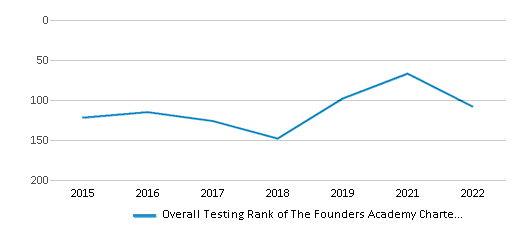
Math Test Scores (% Proficient)
25-29%
40%
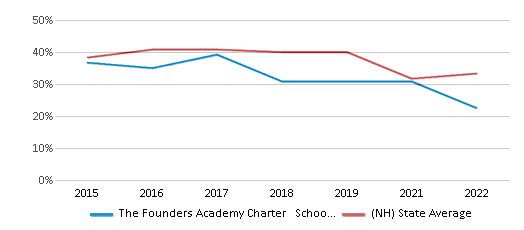
Reading/Language Arts Test Scores (% Proficient)
60-64%
51%
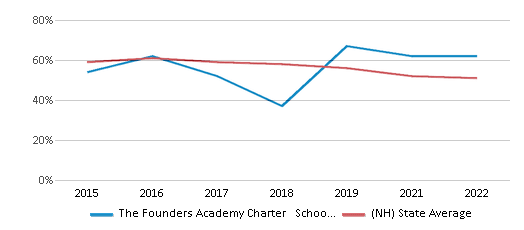
Science Test Scores (% Proficient)
40-49%
36%
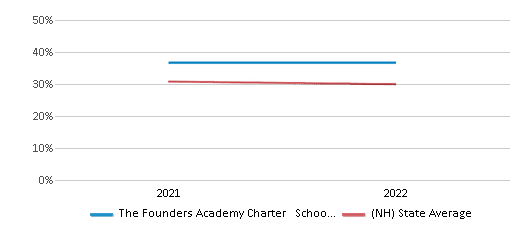
Graduation Rate
≥80%
88%
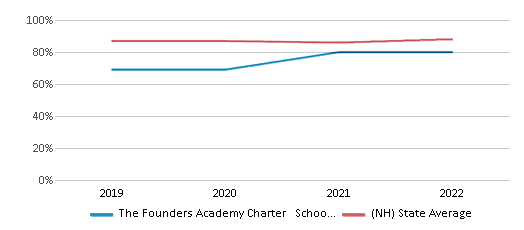
Students by Ethnicity:
Diversity Score
0.43
0.37
# American Indian Students
n/a
6 Students
% American Indian Students
n/a
n/a
# Asian Students
20 Students
497 Students
% Asian Students
5%
9%
# Hispanic Students
50 Students
310 Students
% Hispanic Students
12%
5%
# Black Students
18 Students
119 Students
% Black Students
5%
2%
# White Students
298 Students
4,524 Students
% White Students
74%
79%
# Hawaiian Students
1 Student
9 Students
% Hawaiian Students
n/a
n/a
# Two or more races Students
14 Students
267 Students
% of Two or more races Students
4%
5%
Students by Grade:
# Students in PK Grade:
-
11
# Students in K Grade:
-
377
# Students in 1st Grade:
-
386
# Students in 2nd Grade:
-
394
# Students in 3rd Grade:
-
403
# Students in 4th Grade:
-
416
# Students in 5th Grade:
40
520
# Students in 6th Grade:
77
571
# Students in 7th Grade:
80
512
# Students in 8th Grade:
66
453
# Students in 9th Grade:
45
436
# Students in 10th Grade:
42
431
# Students in 11th Grade:
31
415
# Students in 12th Grade:
20
406
# Ungraded Students:
-
-
Best The Founders Academy Charter School District Public Charter Schools (2025)
School
(Math and Reading Proficiency)
(Math and Reading Proficiency)
Location
Grades
Students
Rank: #11.
The Founders Academy Charter School (H)
Charter School
(Math: 40-59% | Reading: ≥80%)
Rank:
Rank:
9/
Top 20%10
5 Perimeter Rd
Manchester, NH 03103
(603) 952-4705
Manchester, NH 03103
(603) 952-4705
Grades: 9-12
| 138 students
Rank: #22.
The Founders Academy Charter School (E)
Charter School
(Math: 25-29% | Reading: 55-59%)
Rank:
Rank:
5/
Bottom 50%10
5 Perimeter Rd
Manchester, NH 03103
(603) 952-4705
Manchester, NH 03103
(603) 952-4705
Grades: 5-8
| 263 students
Recent Articles

Year-Round Or Traditional Schedule?
Which is more appropriate for your child? A year-round attendance schedule or traditional schedule? We look at the pros and cons.

Why You Should Encourage Your Child to Join a Sports Team
Participating in team sports has a great many benefits for children, there is no doubt. In this article you will learn what those benefits are.

White Students are Now the Minority in U.S. Public Schools
Increasing birth rates among immigrant families from Asia and Central and South America, combined with lower birth rates among white families, means that for the first time in history, public school students in the United States are majority-minority. This shift in demographics poses difficulties for schools as they work to accommodate children of varying language abilities and socio-economic backgrounds.





